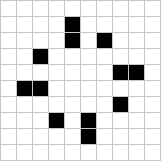Phoenix 1
Phoenix 1 (or flip-flops[1]) is a period-2 oscillator that was discovered by the MIT group in December 1971.[2] It is the smallest known phoenix as well as the first discovered phoenix, and is thus sometimes simply referred to as the phoenix.
| Phoenix 1 | |||||||||||
| |||||||||||
| View animated image | |||||||||||
| View static image | |||||||||||
| Pattern type | Oscillator | ||||||||||
|---|---|---|---|---|---|---|---|---|---|---|---|
| Oscillator type | Phoenix | ||||||||||
| Number of cells | 12 | ||||||||||
| Bounding box | 8×8 | ||||||||||
| Frequency class | 41.4 | ||||||||||
| Period | 2 | ||||||||||
| Mod | 1 | ||||||||||
| Heat | 24 | ||||||||||
| Volatility | 1.00 | ||||||||||
| Strict volatility | 1.00 | ||||||||||
| Rotor type | Flutter | ||||||||||
| Discovered by | MIT group | ||||||||||
| Year of discovery | 1971 | ||||||||||
| |||||||||||
| |||||||||||
| |||||||||||
| |||||||||||
- This article is about the 12-cell oscillator. For the general concept, see Phoenix.
Phoenix 1 consists of four identical three-cell segments, chained in a loop. Other arrangements are possible, to generate larger period 2 phoenices as shown below. A single copy of this rotor can also be supported by a stator: this is an oscillator known as the griddle. The same rotor segment also appears in by flops and why not.
Despite its small size, it had not shown up naturally in soup until October 5, 2015, making it the last 12-bit object to appear naturally;[3] and another soup turned up with this object on October 23.[4] Both of these soups were found by Tomas Rokicki using apgsearch.
Image gallery
See also
References
- "Flip-flops". The Life Lexicon. Stephen Silver. Retrieved on June 21, 2011.
- Dean Hickerson's oscillator stamp collection. Retrieved on March 14, 2020.
- Adam P. Goucher (October 5, 2015). Re: Soup search results (discussion thread) at the ConwayLife.com forums
- Billabob (October 23, 2015). Re: Soup search results (discussion thread) at the ConwayLife.com forums
External links
- Phoenix 1 at the Life Lexicon
- 12P2.6 at Heinrich Koenig's Game of Life Object Catalogs

